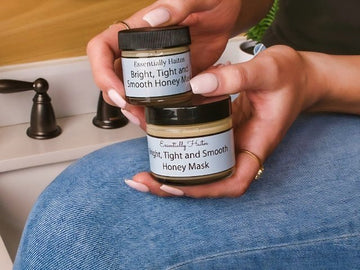Reading skincare labels can be totally confusing – and scary at times! What are all of those long, unpronounceable words and, if I can’t pronounce them, should I even be using them? If you ask yourself these same questions, you’re not alone. That’s exactly how we felt when we first started Essentially Haitos. We read, studied, and relied on other experts to answer our questions – which leads me to Lorraine Dallmeier, Director at Formula Botanica, (which is where I (Karen) study skincare formulation). She dives into some of these common questions that crop up when trying to understand beauty ingredients.
Botanicals vs Synthetics
In our previous blog post (we) covered the basics on how to read a skincare label (Read: How to Read a Skincare Label - Part 1). We discussed how cosmetic ingredients are listed on your labels using a system called the International Nomenclature of Cosmetic Ingredients (INCI).
In Part 2 of this series, we cover how you can tell if an ingredient is synthetic or plant-derived by reading the label.
If I can’t pronounce the ingredient, does that mean it’s a synthetic chemical?
Unfortunately it’s not that simple. Beauty brands are legally required to use a plant’s Latin name when listing it on the label. For that reason, even botanical ingredients can sound overwhelming, confusing and ‘chemical’.
Have a look at these examples:
1. St. John’s Wort is a yellow-flowering herb used in skincare. Its active compounds have antioxidant, anti-inflammatory and antimicrobial properties and the plant offers a red pigment called hypericin. Its INCI name is Hypericum perforatum extract.
2. Tamanu oil is a unique plant oil with a rich green color and an overpowering scent. It’s a great winter carrier oil. Its INCI name is Calophyllum tacamahaca seed oil.
3. Bacuri butter is an Amazonian butter that has a dry skin feel and is rich in palmitic acid. It offers great potential in formulations for dry skin and hair. Its INCI name is Platonia insignis seed oil.
You can see that these names are not always easy to pronounce – and they certainly won’t sound familiar to most people who read their skincare labels.
Remember that if you want to look up your skincare ingredients, the best place to find out what they are is the CosIng database, managed by the European Commission. I like Milady’s Skin Care and Cosmetic Ingredients Dictionary, which is an affordable book for people who want to understand a bit more about their cosmetic ingredients.
Why don’t brands help me understand what’s on my skincare labels?
Thankfully, many of them do! You’ll often see the English name of the botanical extract written in brackets behind the INCI name. For example, you might see:
Hypericum perforatum (St. John’s Wort) extract, Calophyllum tacamahaca (Tamanu) seed oil, Platonia insignis (Bacuri) seed oil.
Many botanical beauty brands are trying hard to help you understand the ingredients on your labels. They will often also explain their ingredients in more detail on their websites and on social media.
Does the skincare label look different if the ingredients are organic?
Sometimes, yes. Your favorite beauty brand might be certified organic, in which case you’ll see their certification logo on the label. Organic certification can be a great way for a beauty brand to elevate itself in the eyes of the discerning shopper.
A brand might also tell you when specific ingredients are organic, but this isn’t allowed in some parts of the world without the brand having gone through organic certification.
Does the skincare label look different if the ingredients are natural or botanical?
Generally speaking, no. The labeling requirements are exactly the same for natural and synthetic ingredients, which means that you don’t always know where the ingredient came from, what it consists of and how it’s been treated before it was added to your formulation.
And just to make life a little bit more complicated, what you think is a natural ingredient might be very different to the next person. The term natural in skincare will mean different things to different people.
Some people are of the opinion that natural cosmetic ingredients are picked directly from a plant and have undergone no or minimal chemical processing. Others will be happy to accept functional ingredients that have been derived from nature but have undergone a degree of chemical processing before they can be used.
For instance, many preservatives are synthesized in a lab – they have exactly the same chemical structure and function as their natural counterpart, but it’s cheaper to manufacture them in bulk in a lab.
So although you won’t necessarily know where your ingredients came from, your skincare label will still use consistent INCI language to give you the low-down on which ingredients are in your cream or lotion. As we’ve now seen though, INCI does have its limitations because it cannot convey all the information we want to know about an ingredient in one small label.
I hope this has given you some pointers on how to understand the ingredients listed on your skincare label. Stay tuned for the final part of this series, in which we’ll be looking at the information your label will never tell you. – Lorraine Dallmeier







